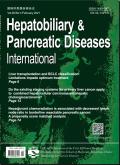Development and validation of a nomogram to predict massive bleeding requiring intervention in severe acute pancreatitis
IF 4.4
3区 医学
Q2 GASTROENTEROLOGY & HEPATOLOGY
Hepatobiliary & Pancreatic Diseases International
Pub Date : 2025-06-18
DOI:10.1016/j.hbpd.2025.06.004
引用次数: 0
Abstract
Background
Hemorrhage remains a formidable complication of severe acute pancreatitis (SAP), with a high mortality rate. However, there is currently no effective method for identifying SAP patients who are at high risk for massive bleeding. The present study aimed to explore risk factors for predicting massive bleeding in SAP patients and to develop a predictive nomogram, which could facilitate early prediction, and timely appropriate interventions.
Methods
We conducted a multivariate logistic regression analysis to examine the relationship between massive bleeding and variables including patient demographics, disease severity, laboratory indexes and local pancreatic complications. A novel nomogram was constructed based on these factors, and was validated both internally and externally assessing its discrimination, calibration, and clinical applicability.
Results
The study involved 351 patients in the training cohort, 104 patients in the internal validation cohort, and 123 patients in the external validation cohort. Logistic regression analysis identified several independent risk factors for massive bleeding, including computed tomography severity index score above 8 points, Acute Physiology and Chronic Health Evaluation II score greater than 16 points, abdominal compartment syndrome, pancreatic fistula, and sepsis. The nomogram constructed from these factors yielded an area under the receiver operating characteristic curve (AUC) of 0.896 and a coefficient of determination (R²) of 0.093. The Hosmer-Lemeshow test indicated good model fitness (P = 0.654). Furthermore, the nomogram demonstrated reliable performance in both validation cohorts.
Conclusions
The nomogram showed strong predictive capability for massive bleeding and could be a valuable tool for clinicians in identifying SAP patients at high risk for this complication at an early stage.
用于预测严重急性胰腺炎需要干预的大出血的影像学发展和验证。
背景:出血仍然是严重急性胰腺炎(SAP)的一个可怕的并发症,死亡率很高。然而,目前还没有有效的方法来识别SAP患者是否有大出血的高风险。本研究旨在探讨预测SAP患者大出血的危险因素,并建立预测图,以便于早期预测,及时采取适当的干预措施。方法:采用多因素logistic回归分析,探讨大出血与患者人口统计学、疾病严重程度、实验室指标及局部胰腺并发症等因素的关系。基于这些因素构建了一个新的nomogram,并对其进行了内部和外部的鉴别、校准和临床适用性验证。结果:本研究纳入351例训练组患者,104例内部验证组患者,123例外部验证组患者。Logistic回归分析确定了大出血的几个独立危险因素,包括计算机断层扫描严重程度指数评分大于8分、急性生理和慢性健康评估II评分大于16分、腹腔隔室综合征、胰瘘和脓毒症。由这些因素组成的nomogram的面积为0.896,决定系数(r2)为0.093。Hosmer-Lemeshow检验显示模型适应度较好(P = 0.654)。此外,nomogram在两个验证队列中表现出可靠的性能。结论:图显示了对大出血的强大预测能力,可以作为临床医生早期识别SAP患者高危并发症的宝贵工具。
本文章由计算机程序翻译,如有差异,请以英文原文为准。
求助全文
约1分钟内获得全文
求助全文
来源期刊
CiteScore
5.40
自引率
6.10%
发文量
152
审稿时长
3.0 months
期刊介绍:
Hepatobiliary & Pancreatic Diseases International (HBPD INT) (ISSN 1499-3872 / CN 33-1391/R) a bimonthly journal published by First Affiliated Hospital, Zhejiang University School of Medicine, China. It publishes peer-reviewed original papers, reviews and editorials concerned with clinical practice and research in the fields of hepatobiliary and pancreatic diseases. Papers cover the medical, surgical, radiological, pathological, biochemical, physiological and historical aspects of the subject areas under the headings Liver, Biliary, Pancreas, Transplantation, Research, Special Reports, Editorials, Review Articles, Brief Communications, Clinical Summary, Clinical Images and Case Reports. It also deals with the basic sciences and experimental work. The journal is abstracted and indexed in SCI-E, IM/MEDLINE, EMBASE/EM, CA, Scopus, ScienceDirect, etc.

 求助内容:
求助内容: 应助结果提醒方式:
应助结果提醒方式:


